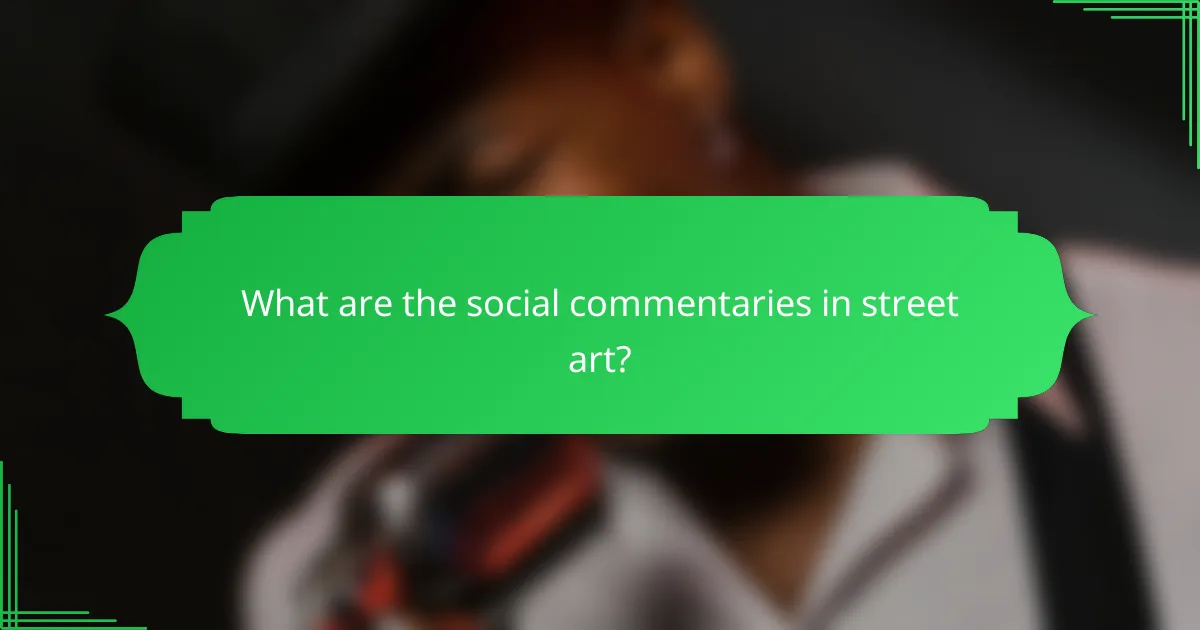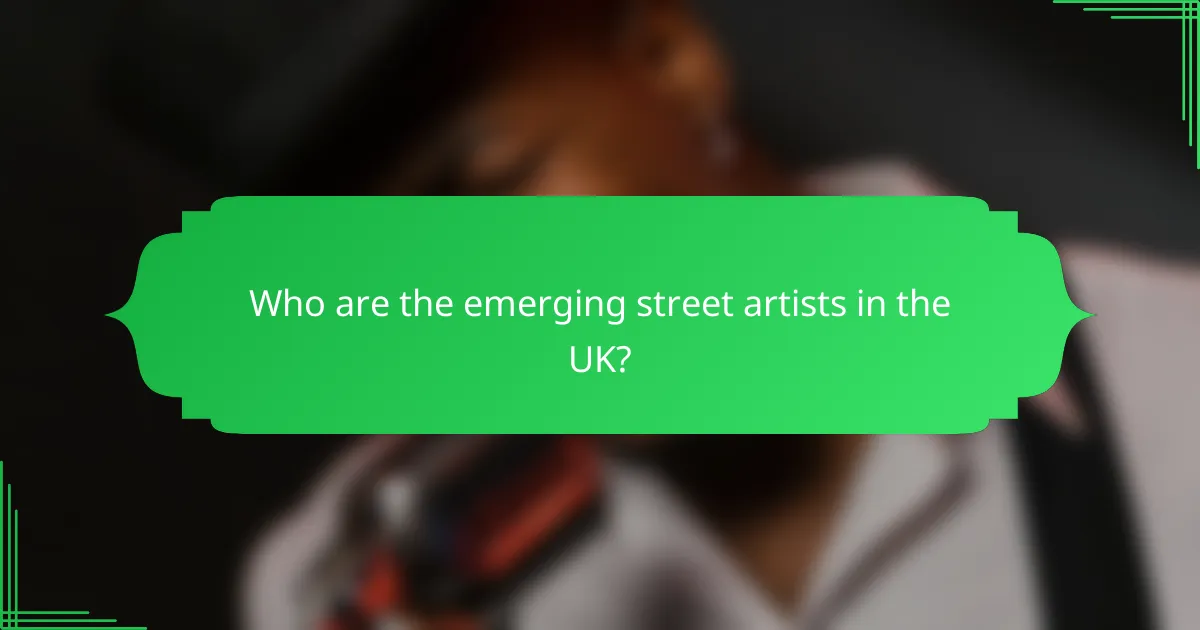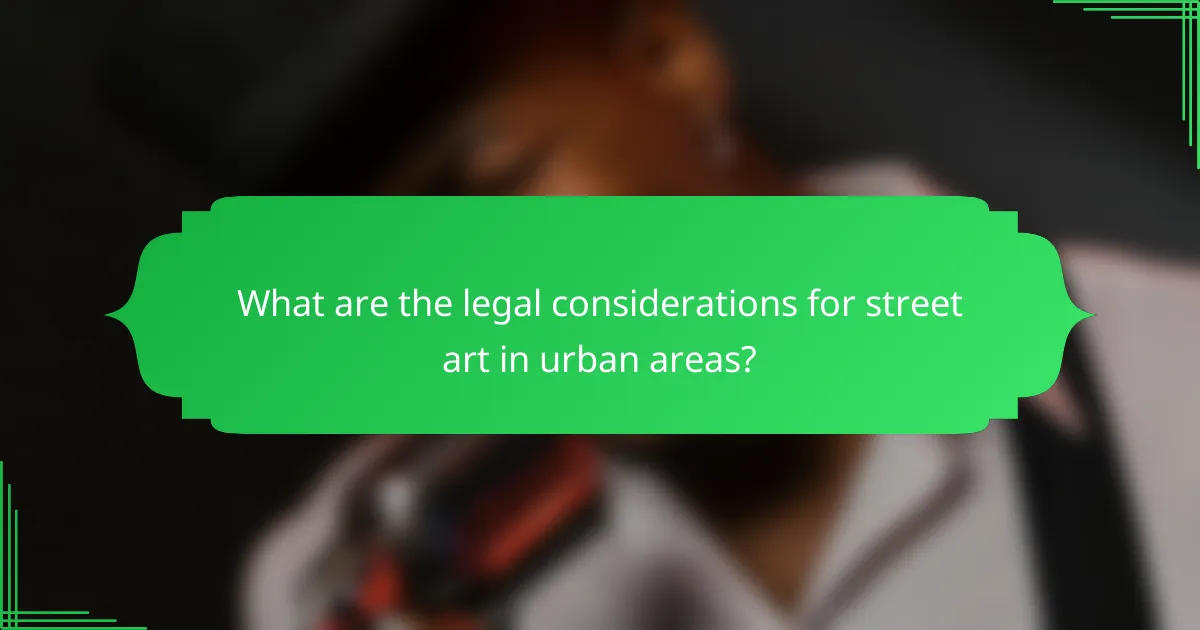Street art is a dynamic reflection of urban culture, offering a canvas for social commentary and community engagement. Emerging artists utilize public spaces to address pressing issues, from politics to social justice, making their thought-provoking works accessible to all. This vibrant art form not only showcases individual creativity but also fosters a dialogue about the values and challenges faced by diverse communities.

How does street art reflect urban culture in London?
Street art in London serves as a vibrant expression of urban culture, showcasing the city’s diversity and social issues. It often acts as a visual commentary on local experiences, resonating with the community and reflecting its values and challenges.
Community engagement
Street art fosters community engagement by transforming public spaces into platforms for dialogue and expression. Local artists often collaborate with residents to create murals that represent shared histories or address social issues, enhancing neighborhood identity.
Events like street art festivals or workshops encourage participation, allowing community members to contribute their perspectives. This involvement not only beautifies the area but also strengthens social ties among residents.
Historical context
The historical context of street art in London dates back to the late 20th century, evolving from graffiti culture to a recognized art form. Initially seen as vandalism, it has gained acceptance as a legitimate means of expression, particularly in areas like Shoreditch and Camden.
Key movements, such as the rise of Banksy, have influenced public perception and policy, leading to a more supportive environment for street artists. This shift reflects broader societal changes regarding art and urban space.
Local artists’ influence
Local artists play a crucial role in shaping the street art scene in London, bringing unique perspectives and styles that resonate with the community. Many artists draw inspiration from their surroundings, creating works that reflect local culture and issues.
Emerging artists often use social media to gain visibility, allowing them to connect with a wider audience and collaborate with established figures. This dynamic fosters a rich artistic ecosystem that continuously evolves, keeping the urban landscape vibrant and relevant.

What are the social commentaries in street art?
Street art often serves as a powerful medium for social commentary, addressing issues that resonate with communities. Through visual expression, artists convey messages about politics, social justice, and environmental concerns, prompting viewers to reflect and engage with these themes.
Political statements
Political statements in street art frequently challenge authority and critique government policies. Artists use public spaces to express dissent, often highlighting issues like corruption, inequality, and civil rights. For example, murals depicting political figures in unflattering ways can provoke discussion and inspire activism.
In many cities, street art becomes a form of protest, especially during election seasons or significant political events. Artists may create works that call for voter participation or raise awareness about specific legislative issues, making art a tool for civic engagement.
Social justice themes
Social justice themes are prevalent in street art, addressing topics such as racial equality, gender rights, and [censured] issues. Artists often use their work to amplify marginalized voices, creating pieces that resonate with local communities and spark dialogue around these critical topics.
For instance, murals that celebrate diversity or depict historical figures in social movements can serve as reminders of ongoing struggles for equality. This type of art not only beautifies urban spaces but also fosters a sense of solidarity and awareness among residents.
Environmental awareness
Environmental awareness in street art highlights the urgent need for action against climate change and ecological degradation. Artists often depict themes related to pollution, deforestation, and wildlife conservation, aiming to educate the public and inspire change.
Murals featuring endangered species or imagery of natural landscapes can evoke emotional responses, encouraging viewers to consider their environmental impact. Community art projects focused on sustainability may also engage local residents in discussions about eco-friendly practices and policies.

Who are the emerging street artists in the UK?
Emerging street artists in the UK are redefining urban culture through their vibrant and thought-provoking works. These artists often use public spaces to convey social commentary, challenge norms, and engage communities, making their art accessible to a wide audience.
Banksy
Banksy is perhaps the most famous street artist globally, known for his satirical and politically charged works. His pieces often critique consumerism, war, and social injustice, making them resonate deeply with the public. Banksy’s anonymity adds to his allure, allowing his art to speak for itself without the influence of personal branding.
His works can be found in various locations across the UK, often appearing overnight and sometimes even disappearing just as quickly. Collectors and fans frequently seek his pieces, which can fetch significant sums at auctions, sometimes reaching hundreds of thousands of pounds.
Stik
Stik is recognized for his simple yet powerful stick figure characters that convey a range of emotions and social messages. His art often addresses themes of community, love, and social issues, making it relatable to a broad audience. Stik’s work has gained popularity in urban areas, particularly in London, where his murals can be seen on various buildings.
Stik also engages in community projects, using his art to foster connections among residents. His commitment to social causes is evident in his collaborations with charities and local organizations, aiming to uplift marginalized voices through art.
Ben Eine
Ben Eine is known for his distinctive typography and colorful letters, which often spell out words with social significance. His work combines elements of graffiti and street art, making it visually striking and thought-provoking. Eine’s pieces can be found in various urban settings, contributing to the vibrancy of the streets.
In addition to his street art, Eine has collaborated with businesses and institutions, bringing his unique style to commercial spaces. His work has been recognized by collectors and institutions alike, with some pieces selling for tens of thousands of pounds, reflecting the growing appreciation for street art as a legitimate art form.

What techniques do street artists use?
Street artists employ a variety of techniques to create their work, each offering unique methods and effects. Common techniques include stencil art, mural painting, and sticker art, each with its own tools, styles, and considerations for execution.
Stencil art
Stencil art involves creating images by cutting shapes into a material, allowing paint to be applied through the cutouts. This technique enables artists to reproduce designs quickly and consistently, making it popular for large-scale works and social messages.
Artists often use cardboard or plastic for stencils, and spray paint is a common medium. The key to effective stencil art is precision in cutting and layering, which can create depth and complexity in the final piece.
Mural painting
Mural painting is the process of painting large images directly onto walls, often transforming public spaces. This technique allows for detailed artwork that can convey powerful narratives or beautify urban environments.
Artists typically use brushes, rollers, or spray paint, and the scale of murals can vary significantly, from small sections to entire building facades. Planning and permission are crucial, as many cities have regulations regarding public art installations.
Sticker art
Sticker art involves creating and placing adhesive designs in public spaces. This technique is often used for quick dissemination of messages or branding, as stickers can be produced in bulk and applied easily.
Artists can use vinyl or paper for stickers, and the designs can range from simple graphics to intricate illustrations. While sticker art is accessible, artists should be mindful of local laws regarding vandalism and public property when placing their work.

How can street art impact local communities?
Street art can significantly influence local communities by fostering creativity, enhancing public spaces, and encouraging social dialogue. It serves as a medium for artistic expression and social commentary, often reflecting the values and issues pertinent to the community.
Urban revitalization
Street art plays a vital role in urban revitalization by transforming neglected areas into vibrant spaces. Murals and installations can attract attention to rundown neighborhoods, leading to increased foot traffic and investment. Cities like Berlin and Melbourne have successfully used street art to rejuvenate districts, resulting in improved local economies.
When planning street art projects, consider collaborating with local artists and community members to ensure the artwork resonates with the area’s identity. This approach not only beautifies the environment but also fosters a sense of ownership among residents.
Tourism attraction
Street art can serve as a powerful draw for tourists, turning cities into open-air galleries. Areas known for their street art often see a surge in visitors, which can boost local businesses such as cafes, shops, and hotels. For instance, neighborhoods like Wynwood in Miami have become iconic tourist destinations due to their colorful murals.
To capitalize on this potential, cities can create guided tours or festivals centered around street art, providing tourists with insights into the artists and their messages. This not only enhances the visitor experience but also supports the local economy.
Community identity
Street art contributes to the formation of community identity by reflecting the unique culture and history of an area. It can convey messages about social issues, celebrate local heritage, or express collective aspirations. This form of art often becomes a symbol of pride for residents, fostering a stronger community bond.
Engaging local artists to create pieces that represent the community’s values can deepen this connection. Additionally, involving residents in the creative process can ensure that the artwork resonates and is embraced by the community, reinforcing a shared identity.

What are the legal considerations for street art in urban areas?
Legal considerations for street art vary significantly based on location, property ownership, and local regulations. Artists must navigate issues such as permission, copyright, and potential penalties for unauthorized work.
Public vs. private property
Street art on public property typically requires permission from local authorities, as it may be subject to regulations regarding vandalism and defacement. In contrast, creating art on private property usually necessitates explicit consent from the property owner.
Unauthorized street art on private property can lead to legal action, including fines or removal of the artwork. Artists should always seek written permission to avoid disputes and ensure their work is protected.
In some cities, there are designated areas for street art, which can provide a legal outlet for artists. Researching local laws and engaging with community programs can help navigate these complexities.
